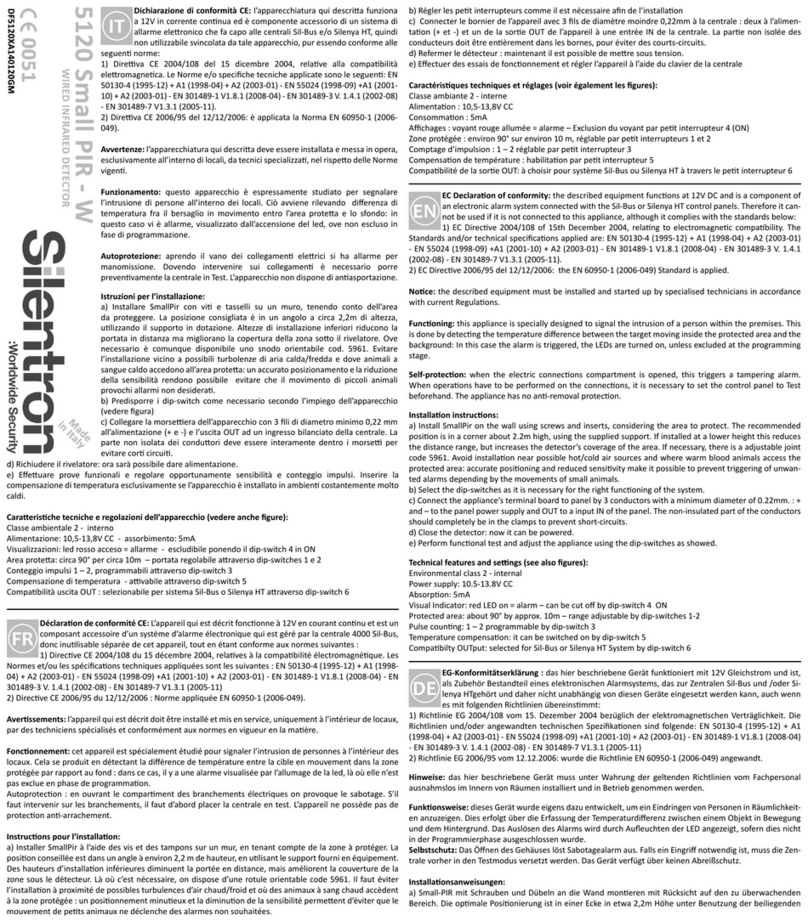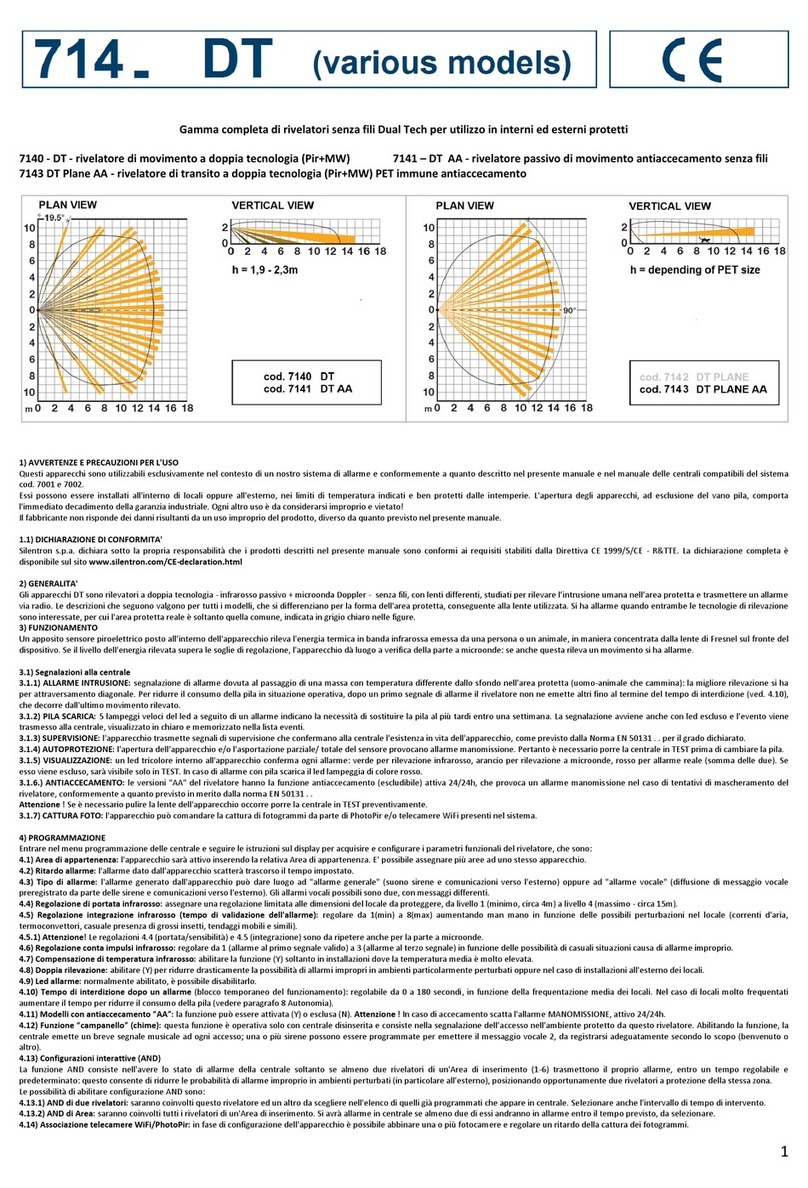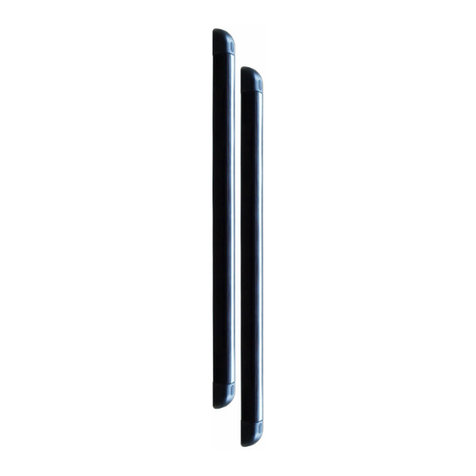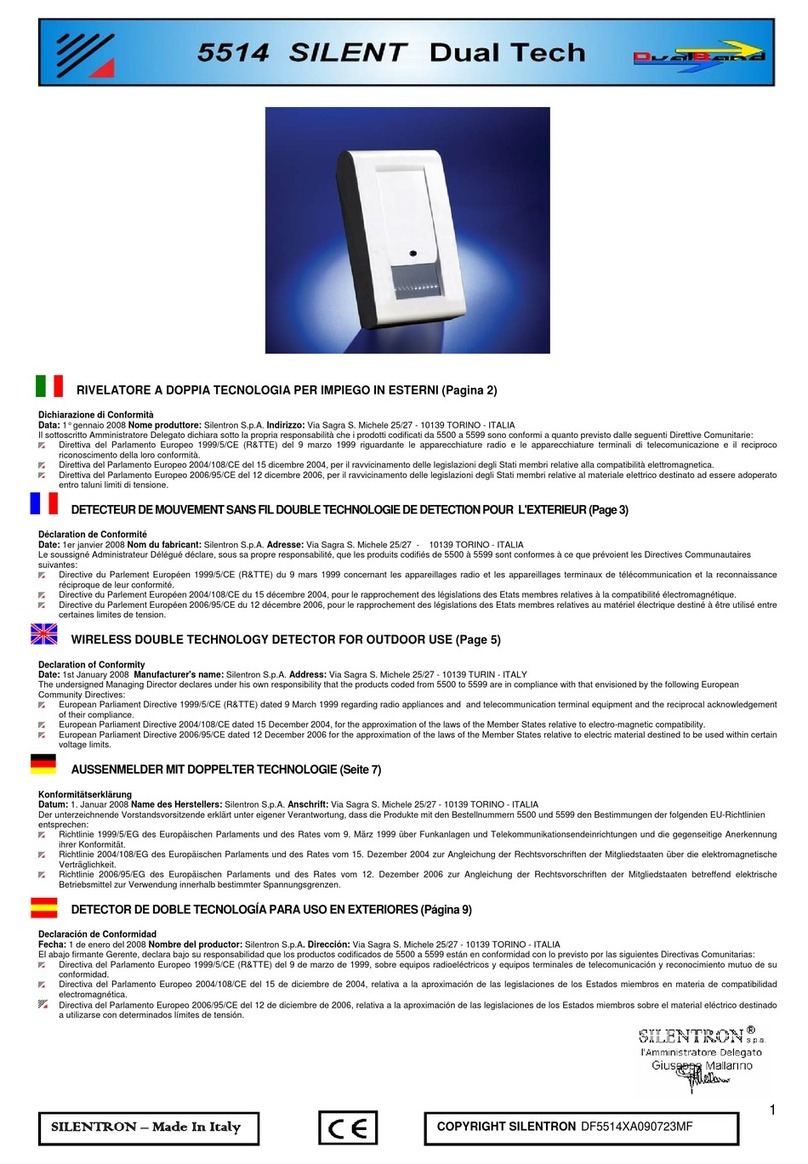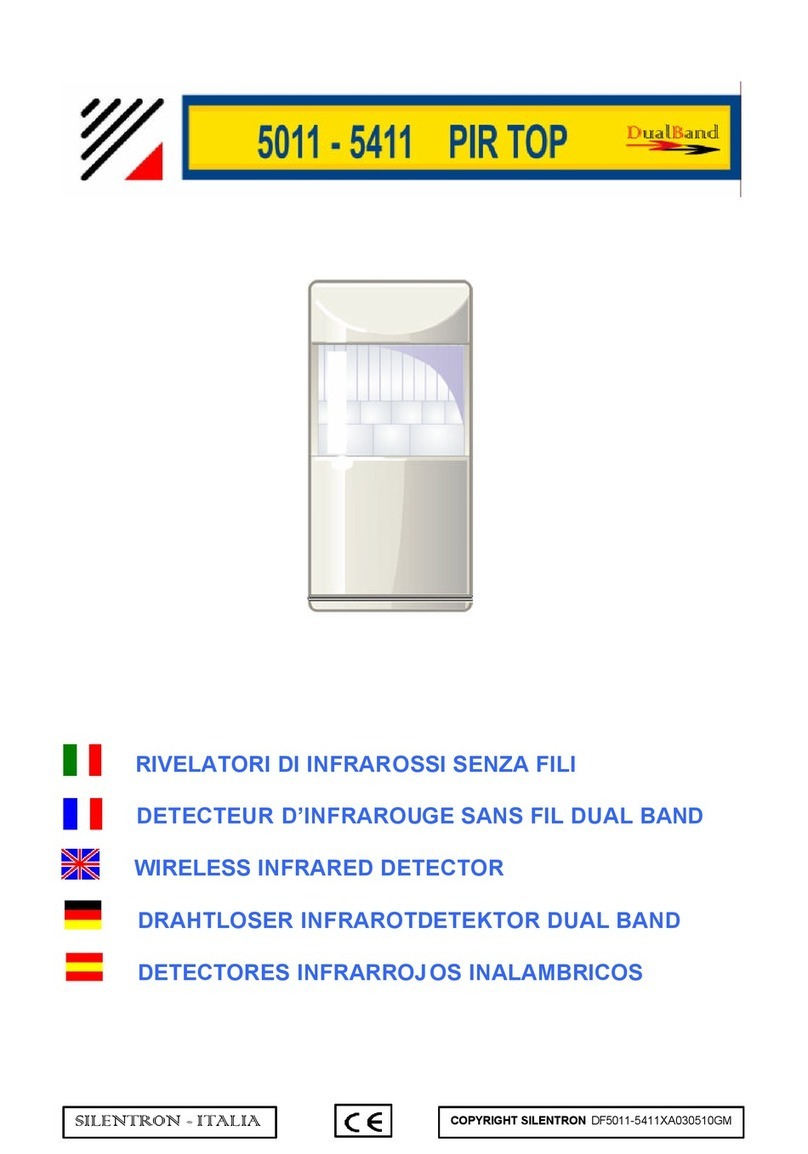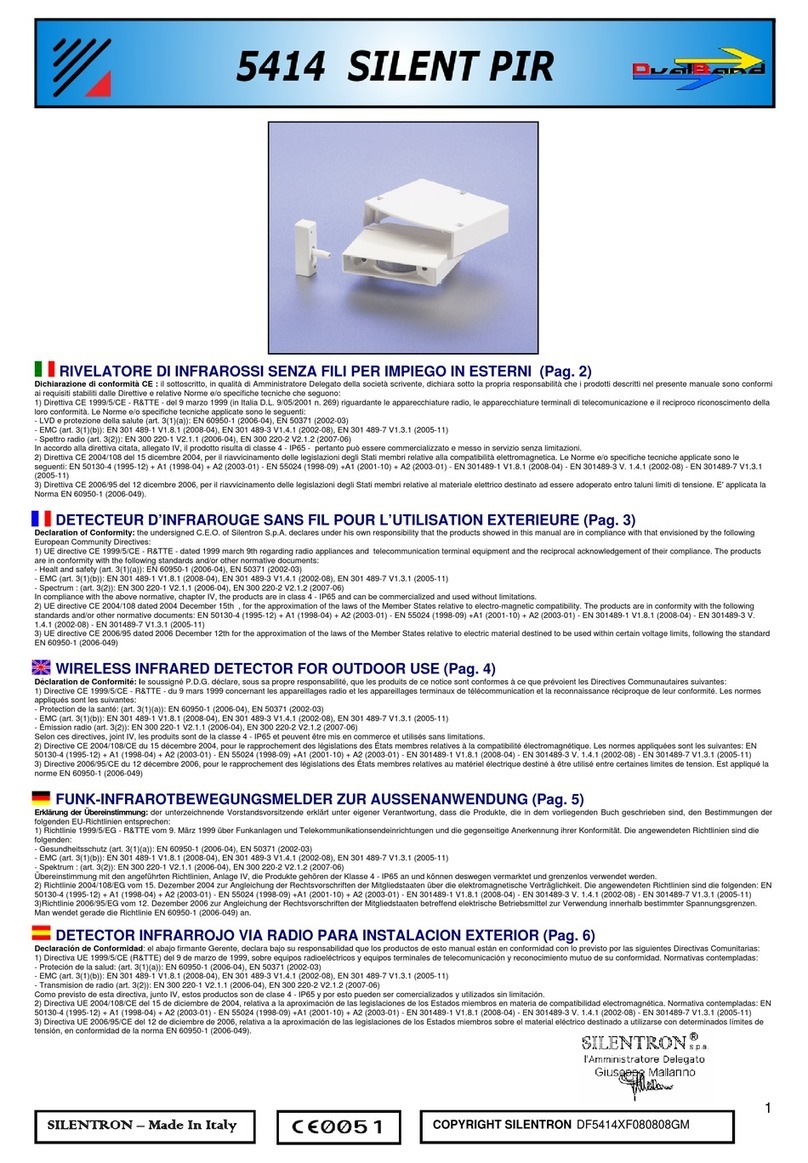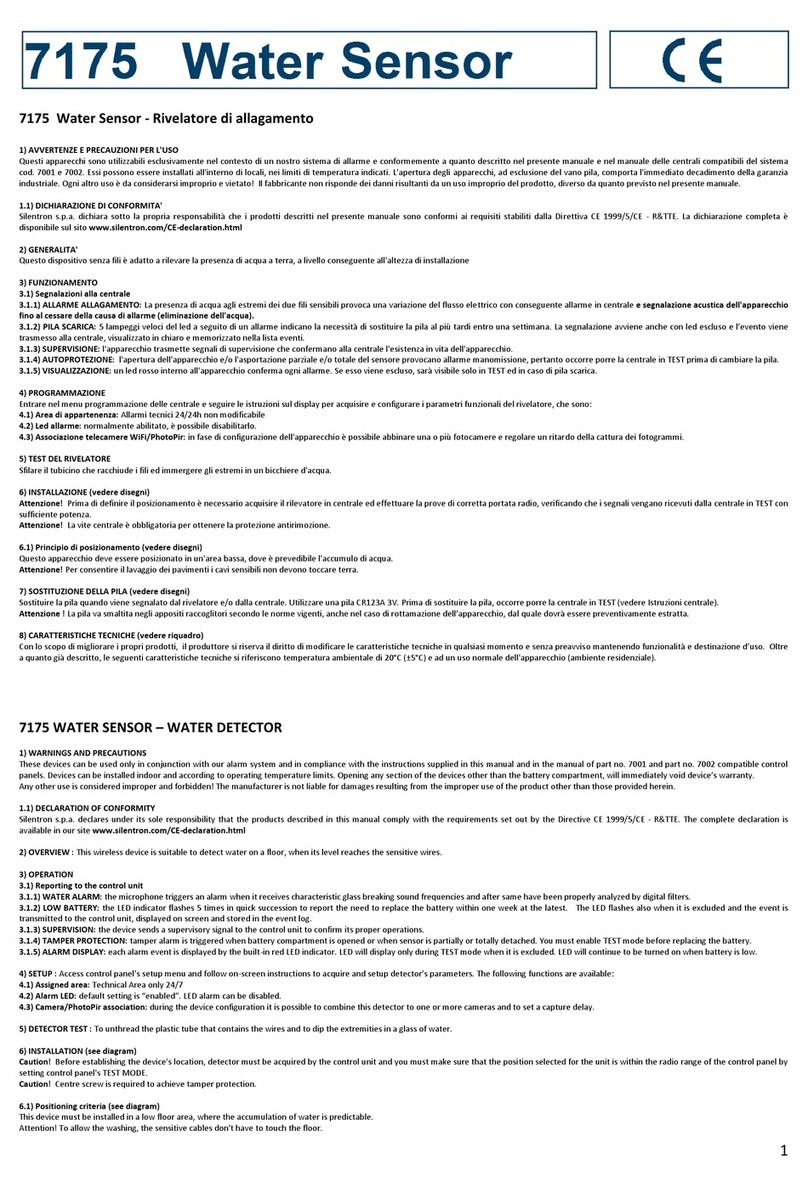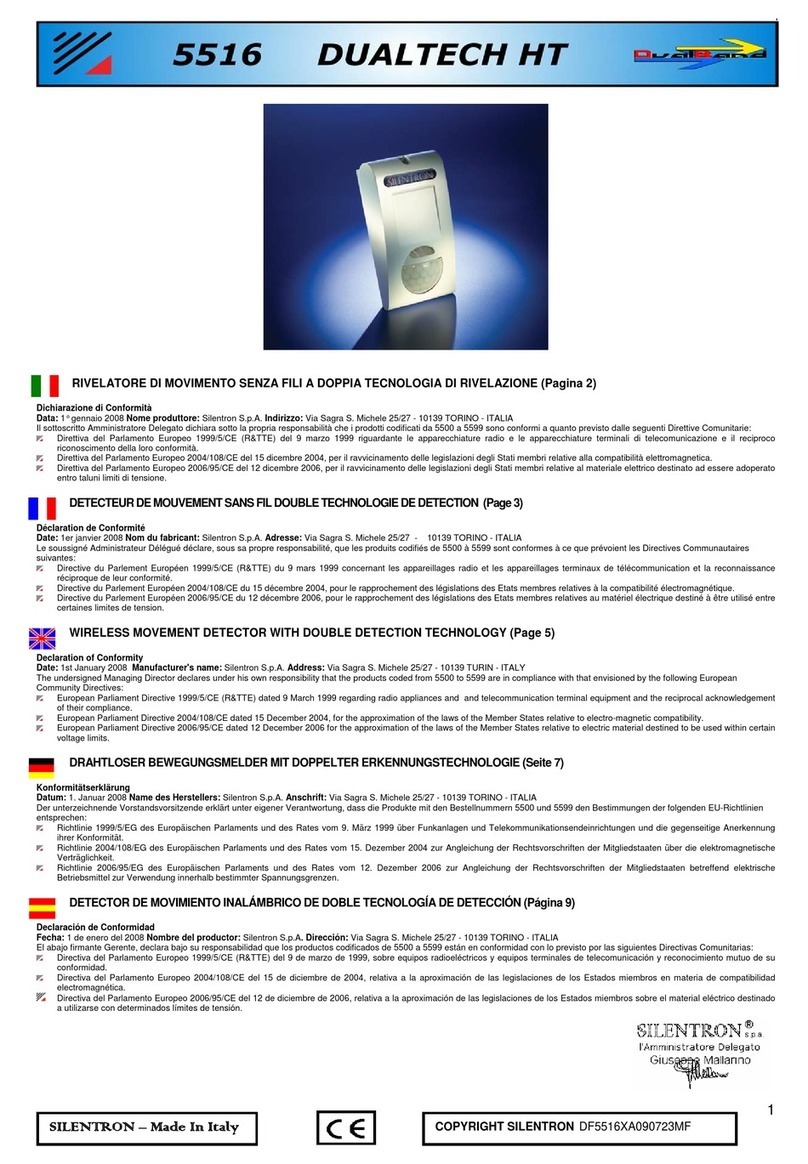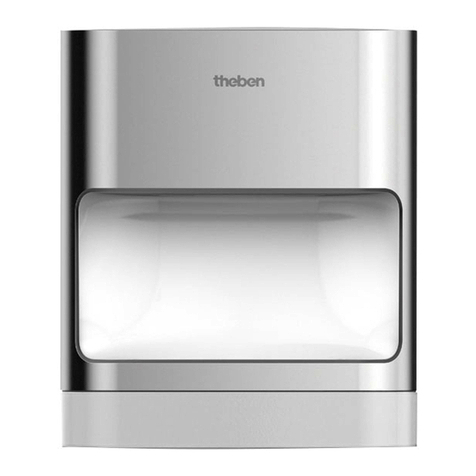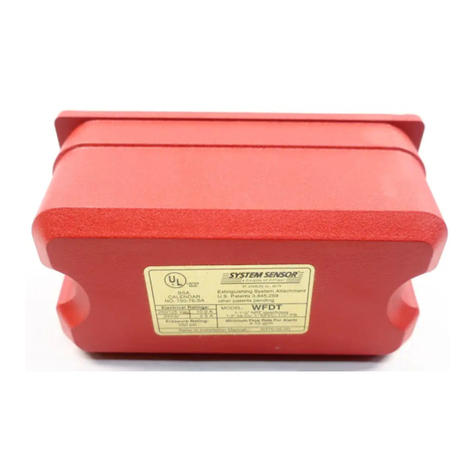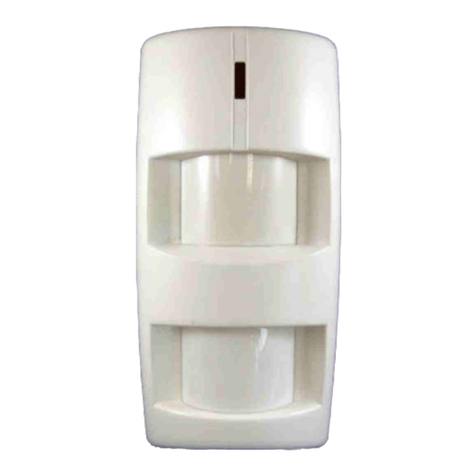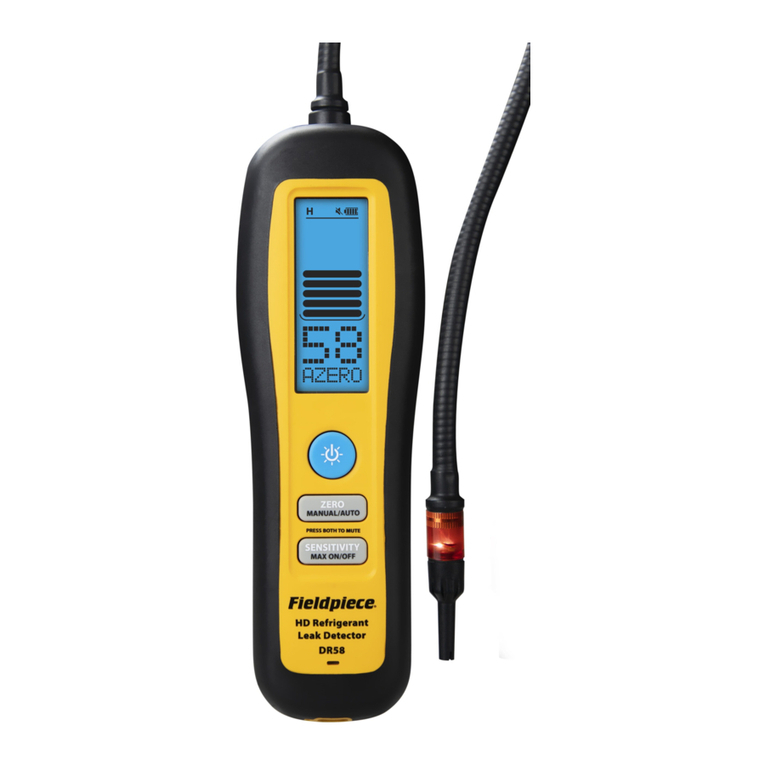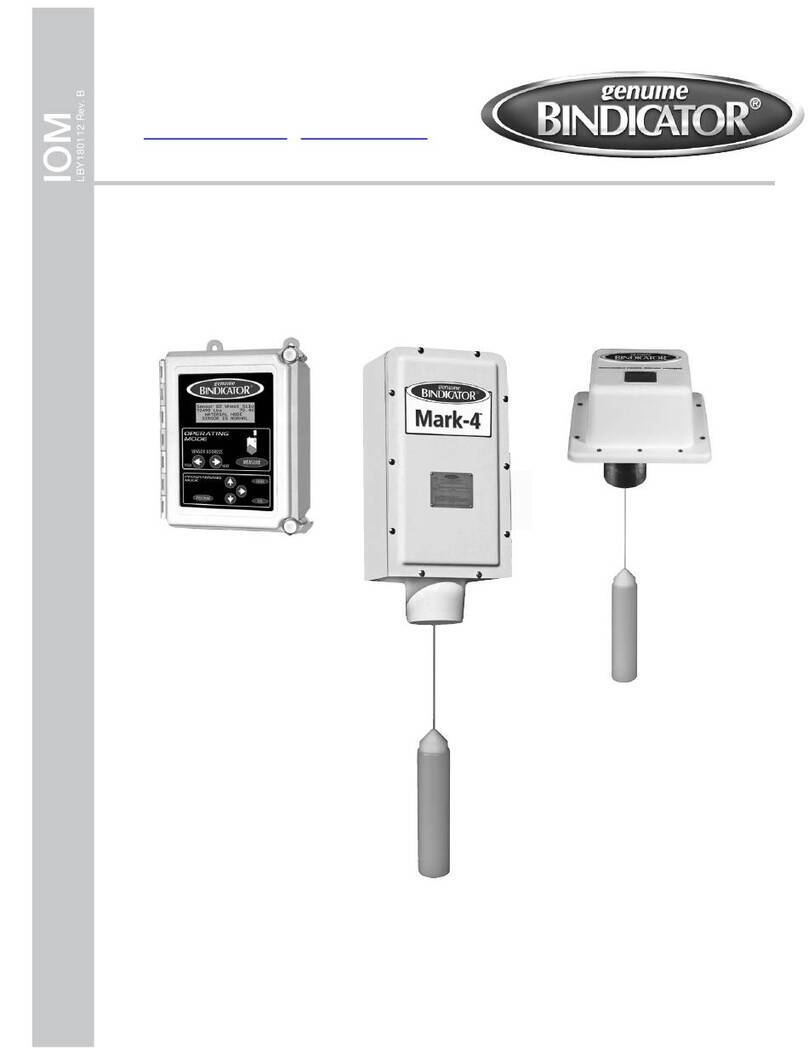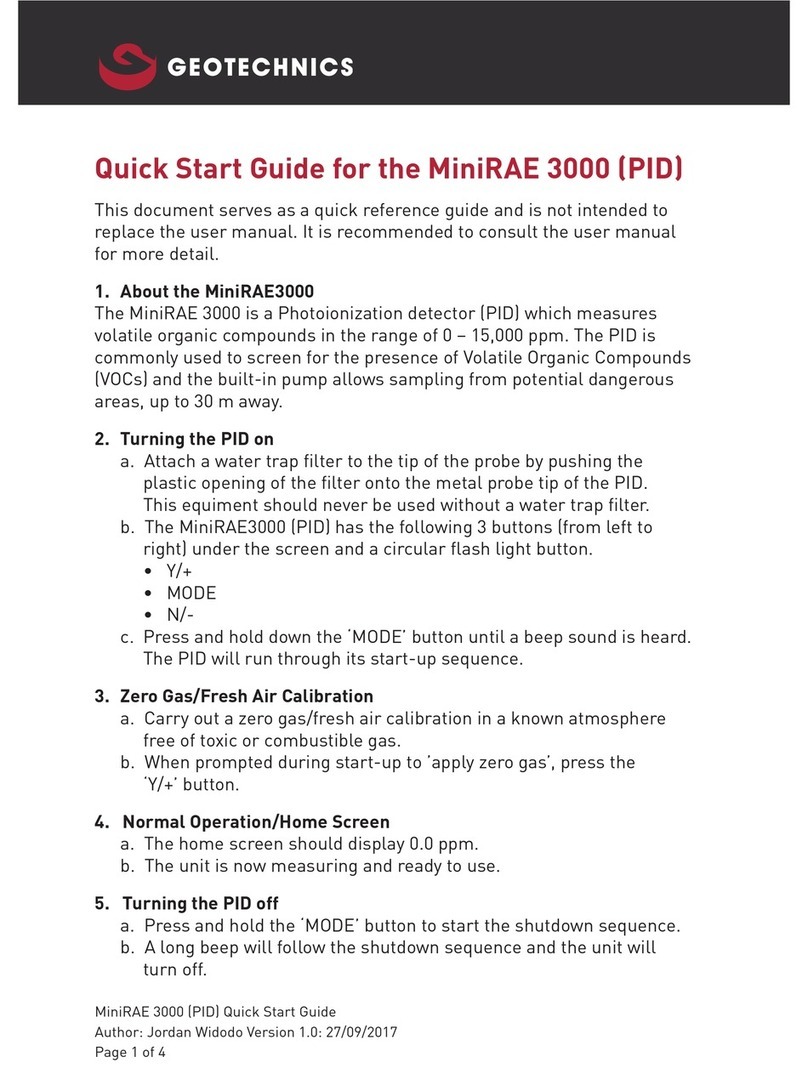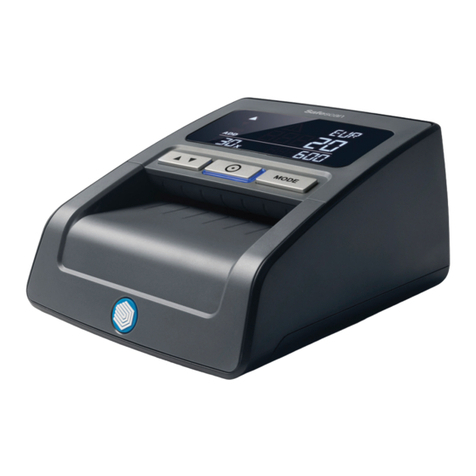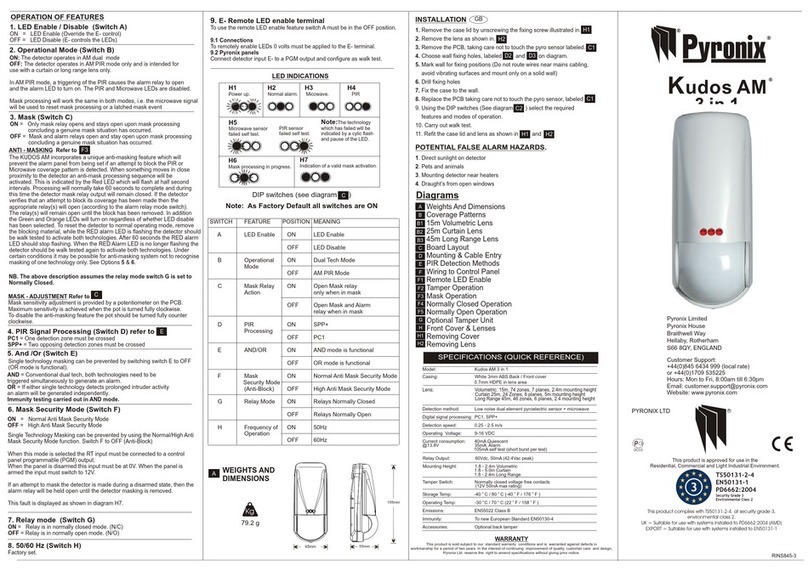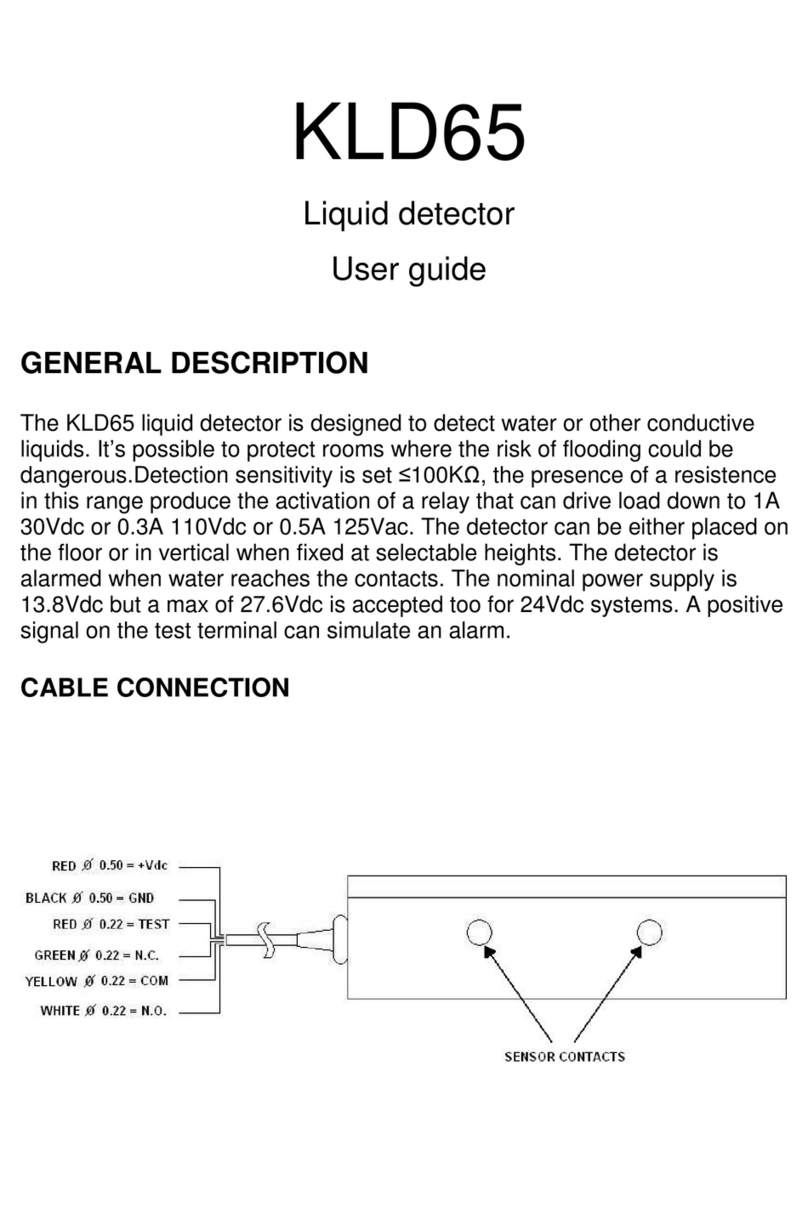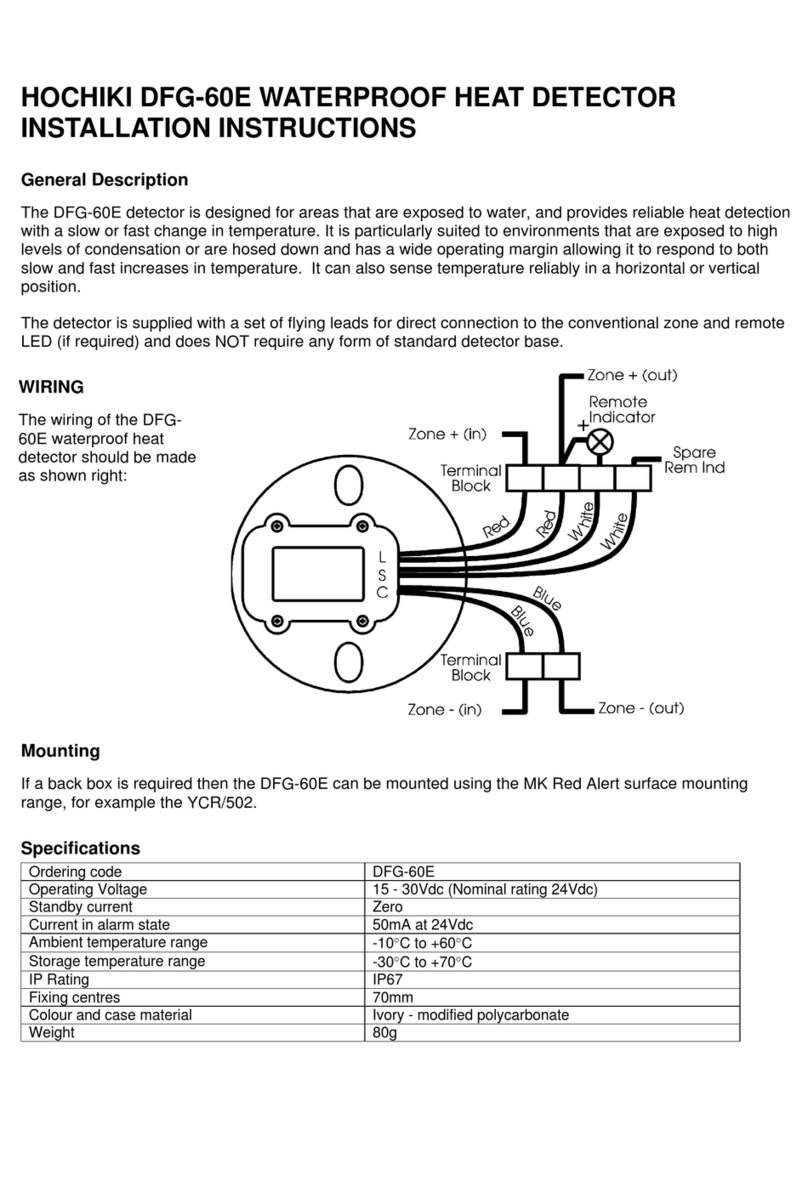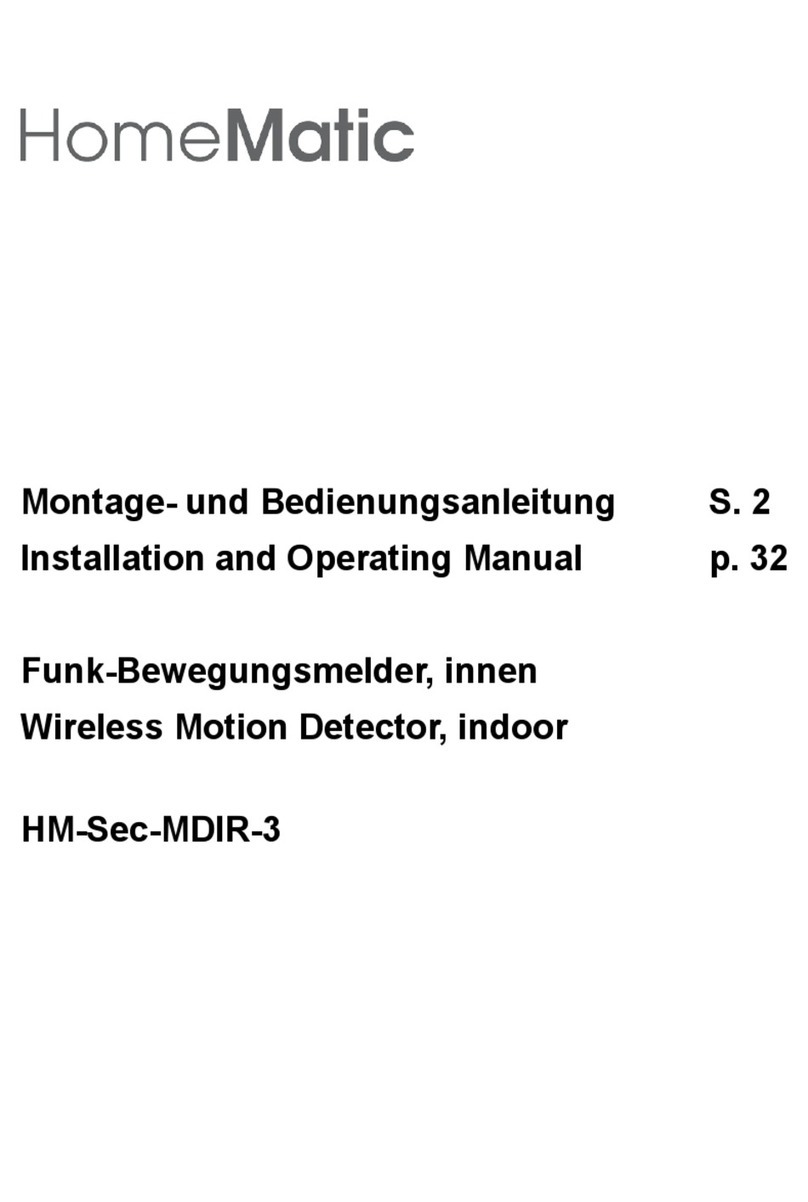
1
SILENTRON
Made In Italy COPYRIGHT SILENTRON DF5511XA090723GM
RIVELATORE PASSIVO DI INFRAROSSI SENZA FILI (Pagina 2)
Dichiarazione di conformità CE : il sottoscritto, in qualità di Amministratore Delegato della società scrivente, dichiara sotto la propria responsabilità che i prodotti descritti nel presente manuale sono conformi
ai requisiti stabiliti dalle Direttive e relative Norme e/o specifiche tecniche che seguono:
1) Direttiva CE 1999/5/CE - R&TTE - del 9 marzo 1999 (in Italia D.L. 9/05/2001 n. 269) riguardante le apparecchiature radio, le apparecchiature terminali di telecomunicazione e il reciproco riconoscimento della
loro conformità. Le Norme e/o specifiche tecniche applicate sono le seguenti:
- LVD e protezione della salute (art. 3(1)(a)): EN 60950-1 (2006-04), EN 50371 (2002-03)
- EMC (art. 3(1)(b)): EN 301 489-1 V1.8.1 (2008-04), EN 301 489-3 V1.4.1 (2002-08), EN 301 489-7 V1.3.1 (2005-11)
- Spettro radio (art. 3(2)): EN 300 220-1 V2.1.1 (2006-04), EN 300 220-2 V2.1.2 (2007-06)
In accordo alla direttiva citata, allegato IV, il prodotto risulta di classe 2 pertanto può essere commercializzato e messo in servizio senza limitazioni.
2) Direttiva CE 2004/108 del 15 dicembre 2004, per il riavvicinamento delle legislazioni degli Stati membri relative alla compatibilità elettromagnetica. Le Norme e/o specifiche tecniche applicate sono le
seguenti: EN 50130-4 (1995-12) + A1 (1998-04) + A2 (2003-01) - EN 55024 (1998-09) +A1 (2001-10) + A2 (2003-01) - EN 301489-1 V1.8.1 (2008-04) - EN 301489-3 V. 1.4.1 (2002-08) - EN 301489-7 V1.3.1
(2005-11)
3) Direttiva CE 2006/95 del 12 dicembre 2006, per il riavvicinamento delle legislazioni degli Stati membri relative al materiale elettrico destinato ad essere adoperato entro taluni limiti di tensione. E' applicata la
Norma EN 60950-1 (2006-049).
DETECTEUR DE MOUVEMENT INFRAROUGE PASSIF SANS FIL (Page3)
Déclaration de Conformité: le soussigné P.D.G. déclare, sous sa propre responsabilité, que les produits de ce notice sont conformes à ce que prévoient les Directives Communautaires suivantes:
1) Directive CE 1999/5/CE - R&TTE - du 9 mars 1999 concernant les appareillages radio et les appareillages terminaux de télécommunication et la reconnaissance réciproque de leur conformité. Les normes
appliqués sont les suivantes:
- Protection de la santé: (art. 3(1)(a)): EN 60950-1 (2006-04), EN 50371 (2002-03)
- EMC (art. 3(1)(b)): EN 301 489-1 V1.8.1 (2008-04), EN 301 489-3 V1.4.1 (2002-08), EN 301 489-7 V1.3.1 (2005-11)
- Émission radio (art. 3(2)): EN 300 220-1 V2.1.1 (2006-04), EN 300 220-2 V2.1.2 (2007-06)
Selon ces directives, joint IV, les produits sont de la classe 2 et peuvent être mis en commerce et utilisés sans limitations.
2) Directive CE 2004/108/CE du 15 décembre 2004, pour le rapprochement des législations des États membres relatives à la compatibilité électromagnétique. Les normes appliquées sont les suivantes: EN
50130-4 (1995-12) + A1 (1998-04) + A2 (2003-01) - EN 55024 (1998-09) +A1 (2001-10) + A2 (2003-01) - EN 301489-1 V1.8.1 (2008-04) - EN 301489-3 V. 1.4.1 (2002-08) - EN 301489-7 V1.3.1 (2005-11)
3) Directive 2006/95/CE du 12 décembre 2006, pour le rapprochement des législations des États membres relatives au matériel électrique destiné à être utilisé entre certaines limites de tension. Est appliqué la
norme EN 60950-1 (2006-049)
WIRELESS PASSIVE INFRARED DETECTOR (Page 5)
Declaration of Conformity: the undersigned C.E.O. of Silentron S.p.A. declares under his own responsibility that the products showed in this manual are in compliance with that envisioned by the following
European Community Directives:
1) UE directive CE 1999/5/CE - R&TTE - dated 1999 march 9th regarding radio appliances and telecommunication terminal equipment and the reciprocal acknowledgement of their compliance. The products
are in conformity with the following standards and/or other normative documents:
- Healt and safety (art. 3(1)(a)): EN 60950-1 (2006-04), EN 50371 (2002-03)
- EMC (art. 3(1)(b)): EN 301 489-1 V1.8.1 (2008-04), EN 301 489-3 V1.4.1 (2002-08), EN 301 489-7 V1.3.1 (2005-11)
- Spectrum : (art. 3(2)): EN 300 220-1 V2.1.1 (2006-04), EN 300 220-2 V2.1.2 (2007-06)
In compliance with the above normative, chapter IV, the products are in class 2 and can be commercialized and used without limitations.
2) UE directive CE 2004/108 dated 2004 December 15th , for the approximation of the laws of the Member States relative to electro-magnetic compatibility. The products are in conformity with the following
standards and/or other normative documents: EN 50130-4 (1995-12) + A1 (1998-04) + A2 (2003-01) - EN 55024 (1998-09) +A1 (2001-10) + A2 (2003-01) - EN 301489-1 V1.8.1 (2008-04) - EN 301489-3 V.
1.4.1 (2002-08) - EN 301489-7 V1.3.1 (2005-11)
3) UE directive CE 2006/95 dated 2006 December 12th for the approximation of the laws of the Member States relative to electric material destined to be used within certain voltage limits, following the standard
EN 60950-1 (2006-049)
DRAHTLOSER PASSIVER INFRAROTMELDER (Seite 7)
Erklärung der Übereinstimmung: der unterzeichnende Vorstandsvorsitzende erklärt unter eigener Verantwortung, dass die Produkte, die in dem vorliegenden Buch geschrieben sind, den Bestimmungen der
folgenden EU-Richtlinien entsprechen:
1) Richtlinie 1999/5/EG - R&TTE vom 9. März 1999 über Funkanlagen und Telekommunikationsendeinrichtungen und die gegenseitige Anerkennung ihrer Konformität. Die angewendeten Richtlinien sind die
folgenden:
- Gesundheitsschutz (art. 3(1)(a)): EN 60950-1 (2006-04), EN 50371 (2002-03)
- EMC (art. 3(1)(b)): EN 301 489-1 V1.8.1 (2008-04), EN 301 489-3 V1.4.1 (2002-08), EN 301 489-7 V1.3.1 (2005-11)
- Spektrum : (art. 3(2)): EN 300 220-1 V2.1.1 (2006-04), EN 300 220-2 V2.1.2 (2007-06)
Übereinstimmung mit den angeführten Richtlinien, Anlage IV, die Produkte gehören der Klasse 2 an und können deswegen vermarktet und grenzenlos verwendet werden.
2) Richtlinie 2004/108/EG vom 15. Dezember 2004 zur Angleichung der Rechtsvorschriften der Mitgliedstaaten über die elektromagnetische Verträglichkeit. Die angewendeten Richtlinien sind die folgenden: EN
50130-4 (1995-12) + A1 (1998-04) + A2 (2003-01) - EN 55024 (1998-09) +A1 (2001-10) + A2 (2003-01) - EN 301489-1 V1.8.1 (2008-04) - EN 301489-3 V. 1.4.1 (2002-08) - EN 301489-7 V1.3.1 (2005-11)
3)Richtlinie 2006/95/EG vom 12. Dezember 2006 zur Angleichung der Rechtsvorschriften der Mitgliedstaaten betreffend elektrische Betriebsmittel zur Verwendung innerhalb bestimmter Spannungsgrenzen.
Man wendet gerade die Richtlinie EN 60950-1 (2006-049) an.
DETECTOR PASIVO DE INFRARROJOS INALÁMBRICO (Página 9)
Declaración de Conformidad: el abajo firmante Gerente, declara bajo su responsabilidad que los productos de esto manual están en conformidad con lo previsto por las siguientes Directivas Comunitarias:
1) Directiva UE 1999/5/CE (R&TTE) del 9 de marzo de 1999, sobre equipos radioeléctricos y equipos terminales de telecomunicación y reconocimiento mutuo de su conformidad. Normativas contempladas:
- Proteción de la salud: (art. 3(1)(a)): EN 60950-1 (2006-04), EN 50371 (2002-03)
- EMC (art. 3(1)(b)): EN 301 489-1 V1.8.1 (2008-04), EN 301 489-3 V1.4.1 (2002-08), EN 301 489-7 V1.3.1 (2005-11)
- Transmision de radio (art. 3(2)): EN 300 220-1 V2.1.1 (2006-04), EN 300 220-2 V2.1.2 (2007-06)
Como previsto de esta directiva, junto IV, estos productos son de clase 2 y por esto pueden ser comercializados y utilizados sin limitación.
2) Directiva UE 2004/108/CE del 15 de diciembre de 2004, relativa a la aproximación de las legislaciones de los Estados miembros en materia de compatibilidad electromagnética. Normativa contempladas: EN
50130-4 (1995-12) + A1 (1998-04) + A2 (2003-01) - EN 55024 (1998-09) +A1 (2001-10) + A2 (2003-01) - EN 301489-1 V1.8.1 (2008-04) - EN 301489-3 V. 1.4.1 (2002-08) - EN 301489-7 V1.3.1 (2005-11)
3) Directiva UE 2006/95/CE del 12 de diciembre de 2006, relativa a la aproximación de las legislaciones de los Estados miembros sobre el material eléctrico destinado a utilizarse con determinados límites de
tensión, en conformidad de la norma EN 60950-1 (2006-049).












